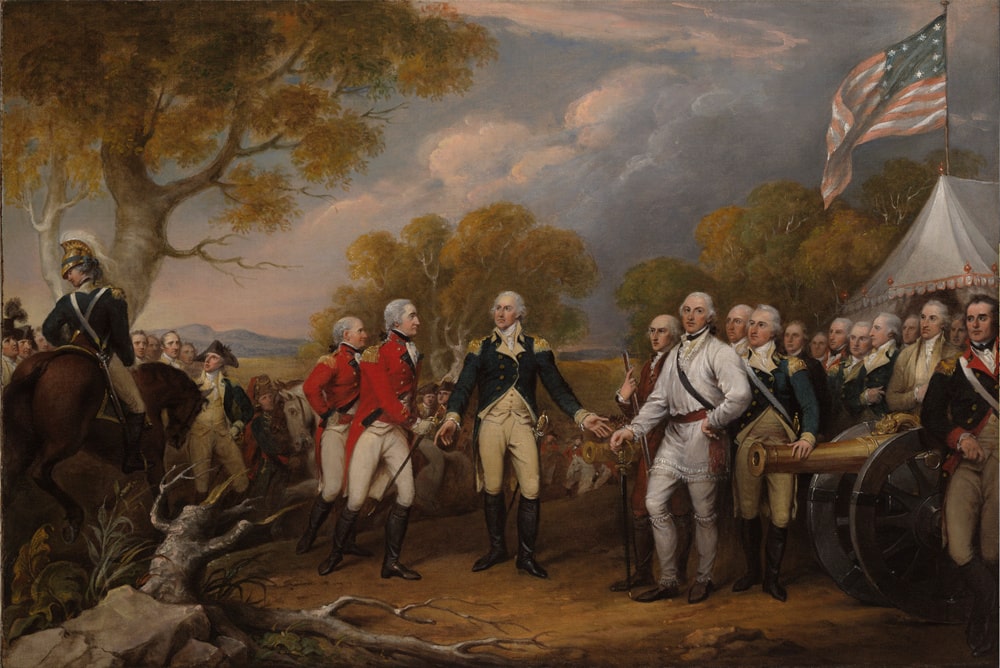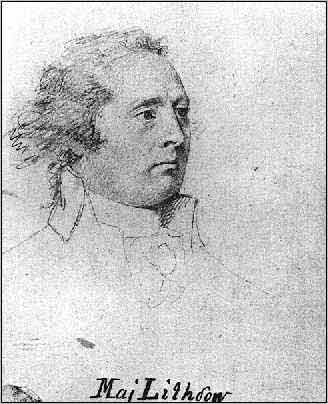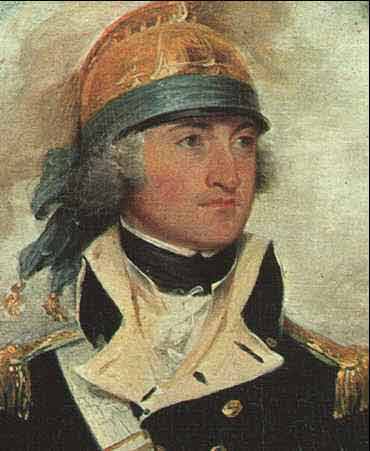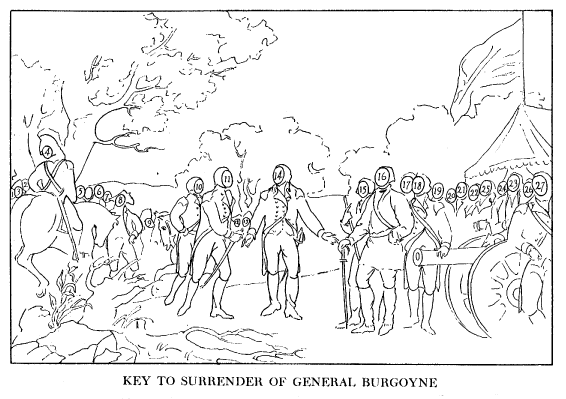
Jump to key figures in this painting.
This painting represents General Burgoyne on October 16, 1777, attended by General Phillips, and followed by other officers, arriving at the field tent of General Gates with a number of the principal officers of the American army assembled nearby.
The confluence of Fish Creek and the North River, where the British left their arms, is shown in the distance, near the head of Col. Scammell; the troops are indistinctly seen crossing the creek and the meadows, under the direction of Colonel (later Governor) Lewis, then quarter-master general, and advancing towards the foreground; they disappear behind the wood, which serves as a backdrop to the three principal figures; and again appear (grenadiers, without arms or accoutrements) under the left arm of General Gates. Officers on horseback, American, British, and German, precede the head of the column, and form an interesting cavalcade, following the two dismounted generals, and connecting different parts of the picture.
Trumbull planned this picture as early as 1786, as it is in the list agreed upon in conference with Jefferson and Adams, but in his proposals to publish engravings (New York, April 2, 1790) it is stated that it had not as yet been executed.
Among Trumbulls’ effects was a finished sketch in outline and partly filled in with India ink, endorsed on the back by Trumbull “Surrender of General Burgoyne, Lebanon, August 1791”. Another was a pencil sketch endorsed with the proportions of the figures. A third was an outline sketch in pencil of General Gates’ tent, as it appears in the finished picture. A fourth was a finished sketch in sepia endorsed “Saratoga, scene from the rising ground nigh the church, on which was General Gates’s marquee, Sep. 28, 1791, J. Trumbull.” A fifth was a sketch in pencil endorsed “Maj. Gen. Gates New York Dec. 1790”; also a pencil portrait endorsed “B. Gen. Glover, Marblehead Nov. 13, 1794”
At Yale University, one can find the following miniature portraits endorsed on the back by Trumbull with the name and date when painted and the words “Capture of General Burgoyne,” evidently used in this painting:
Major Lithgow of Massachusetts, 1791 (above)
Col. John Brooks, Painted at Boston, 1790
Lieut. Col. Richard Butler, Painted at Philadelphia, 1790
Major Jonathan Haskell. Painted at Charleston, So. Carolina, 1791
Major Isaac Hull, Painted at Boston, 1790
Brigadier-General Morgan, “of the American Riflemen, distinguished at the Cow Pens, and present at the capture of General Burgoyne.” Painted at Philadelphia, 1792 from an original by C. W. Peale
Col. Rufus Putnam, Painted at New York, 1790
Major-General Philip Schuyler, Painted at Philadelphia, 1792
Capt. Thomas Youngs Seymour, Painted at Hartford, 1793 (above)
Col. William Stevens, “Commander of the American Artillery at the capture of General Burgoyne.” Painted in New York, 1790.
From the general composition and evidence in the canvas itself, it is probable that Trumbull painted this picture between 1816 and 1824 after he had been commissioned by Congress to decorate the Rotunda of the Capitol with this scene. He used his early sketches and miniatures as the base, but the finished canvas entirely lacks the spirit of his early compositions planned and executed while in West’s studio, and it is only necessary to compare the heads of General Morgan and Captain Seymour, as they appear in the finished painting, with the original miniatures from which they were adapted, to realize the deterioration in Trumbull’s art.
Key figures in this painting
- Major Lithgow, Mass.
- Colonel Cilley, New Hampshire
- General Stark, New Hampshire
- Captain Seymour, Connecticut
- Major Hull, Mass.
- Col. Greaton, Mass.
- Major Dearborn, New Hampshire
- Colonel Scammell, New Hampshire
- Colonel Lewis, New York
- Maj. Gen. Phillips, British
- Lt. General Burgoyne
- General Baron Reidesel, German
- Colonel Wilkinson
- General Gates
- Colonel Prescott, Massachusetts
- Colonel Morgan, Virginia Riflemen
- Brigadier General Rufus Putnam
- Lt. Colonel John Brooks
- Rev Hitchcock
- Major R. Troup
- Major Haskell, Massachusetts
- Major Armstrong
- Maj General Philip Schuyler, New York
- Brig. Gen. Glover
- Brigadier General Whipple, New Hampshire
- Maj. M. Clarkson, New York
- Major Ebenezer Stevens, commanding the Artillery




